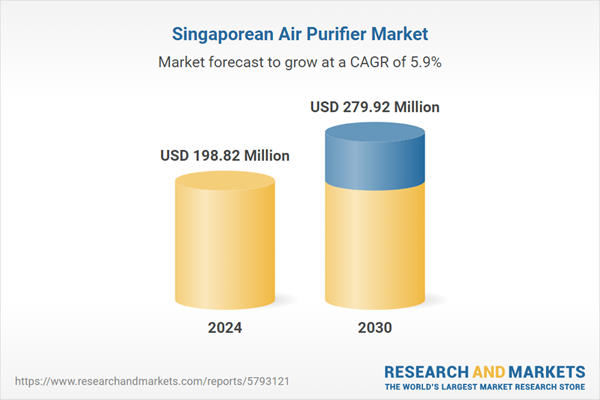Speak directly to the analyst to clarify any post sales queries you may have.
10% Free customizationThis report comes with 10% free customization, enabling you to add data that meets your specific business needs.
The market is characterized by advanced technologies such as HEPA filters, activated carbon, and smart connectivity features that enable real-time air quality monitoring and remote control via mobile apps. Residential demand dominates, especially among families and health-conscious individuals, while commercial and healthcare sectors also contribute significantly. Additionally, government initiatives promoting clean air and stricter environmental regulations are boosting market adoption.
Key Market Drivers
Rising Urban Pollution and Increasing Air Quality Concerns
One of the primary drivers propelling the Singapore air purifier market is the growing concern over urban pollution and deteriorating air quality. In 2025, Singapore remains fully urbanized with a 100% urbanization rate, reflecting its status as a highly developed and densely populated city-state. Singapore, despite being a highly developed city-state with stringent environmental regulations, frequently experiences episodes of haze caused by transboundary smoke from forest fires in neighboring countries. This seasonal haze significantly degrades air quality, elevating particulate matter (PM2.5 and PM10) to hazardous levels.Besides haze, urban pollution sources like vehicular emissions, industrial activities, and construction dust contribute to indoor and outdoor air pollution. These environmental challenges have heightened awareness among Singaporeans about the importance of maintaining clean indoor air, especially since people spend a majority of their time indoors - at home, work, or school. Air pollution is linked to adverse health effects such as respiratory problems, asthma, allergies, and cardiovascular diseases, motivating consumers to seek protective solutions. As a result, demand for air purifiers that can effectively filter out pollutants like dust, smoke, and harmful gases has surged, making air quality improvement a vital market driver.
Key Market Challenges
High Initial Cost and Maintenance Expenses
One of the foremost challenges confronting the Singapore air purifier market is the relatively high upfront cost of quality air purification devices and their ongoing maintenance expenses. Premium air purifiers equipped with advanced HEPA filters, activated carbon layers, and smart features tend to come with a significant price tag, which may deter price-sensitive consumers. While some budget-friendly models are available, they often lack the efficacy and durability required to meet stringent air quality needs, leading to consumer hesitation.Additionally, air purifiers require periodic filter replacements, which can be costly over time. Filters typically need changing every six to twelve months depending on usage, and the cost of genuine replacement filters can be a recurring financial burden. Furthermore, maintenance of sensor accuracy and occasional servicing to ensure optimal functioning adds to the total cost of ownership. This combination of high initial investment and continuous maintenance can limit market penetration, especially among lower-income households or those who view air purifiers as non-essential luxury appliances rather than health necessities.
Key Market Trends
Growing Adoption of Smart and IoT-Enabled Air Purifiers
A major trend in the Singapore air purifier market is the growing adoption of smart, Internet of Things (IoT)-enabled devices that offer enhanced user control and automation. In 2023, internet penetration in Singapore reached 94.3%, highlighting its highly connected digital landscape. Consumers increasingly prefer air purifiers integrated with advanced sensors that provide real-time air quality data, allowing them to monitor pollution levels directly from their smartphones via dedicated apps.These smart purifiers can automatically adjust their purification intensity based on detected air quality, improving efficiency and energy consumption. Features such as voice control through platforms like Google Assistant and Amazon Alexa are gaining popularity, aligning with Singapore’s tech-savvy population and Smart Nation initiatives. Additionally, app notifications for filter replacement, maintenance reminders, and remote operation add convenience and improve user experience. This trend not only reflects consumers’ demand for more interactive and user-friendly devices but also encourages manufacturers to innovate continuously, creating a competitive advantage in the market.
Key Market Players
- Philips Singapore Pte Ltd.
- Samsung Electronics Singapore Pte. Ltd. (SESP)
- LG Electronics Singapore Pte.Ltd.(LGESL)
- Xiaomi Technologies Singapore Pte. Ltd.
- Electrolux S.E.A. Pte Ltd
- Daikin Airconditioning (Singapore) Pte Ltd.
- Sharp Singapore Electronics Corporation Pte. Ltd.
- Arovast Corporation (Levoit)
- Sterra
- Futur Living Pte Ltd
Report Scope:
In this report, the Singapore Air Purifier Market has been segmented into the following categories, in addition to the industry trends which have also been detailed below:Singapore Air Purifier Market, By Product Type:
- HEPA + Activated Carbon
- HEPA + Activated Carbon + Pre-Filter
- HEPA + Pre-Filter
- Others
Singapore Air Purifier Market, By Distribution Channel:
- Supermarkets/Hypermarkets
- Multi-Branded Stores
- Online
- Others
Singapore Air Purifier Market, By Region:
- North-East
- Central
- East
- West
- North
Competitive Landscape
Company Profiles: Detailed analysis of the major companies present in the Singapore Air Purifier Market.Available Customizations:
With the given market data, the publisher offers customizations according to a company's specific needs. The following customization options are available for the report.Company Information
- Detailed analysis and profiling of additional market players (up to five).
This product will be delivered within 1-3 business days.
Table of Contents
Companies Mentioned
- Philips Singapore Pte Ltd.
- Samsung Electronics Singapore Pte. Ltd. (SESP)
- LG Electronics Singapore Pte.Ltd.(LGESL)
- XIAOMI TECHNOLOGIES SINGAPORE PTE. LTD.
- Electrolux S.E.A. Pte Ltd
- Daikin Airconditioning (Singapore) Pte Ltd.
- Sharp Singapore Electronics Corporation Pte. Ltd.
- Arovast Corporation (Levoit)
- Sterra
- Futur Living Pte Ltd
Table Information
| Report Attribute | Details |
|---|---|
| No. of Pages | 70 |
| Published | September 2025 |
| Forecast Period | 2024 - 2030 |
| Estimated Market Value ( USD | $ 198.82 Million |
| Forecasted Market Value ( USD | $ 279.92 Million |
| Compound Annual Growth Rate | 5.8% |
| Regions Covered | Singapore |
| No. of Companies Mentioned | 10 |









